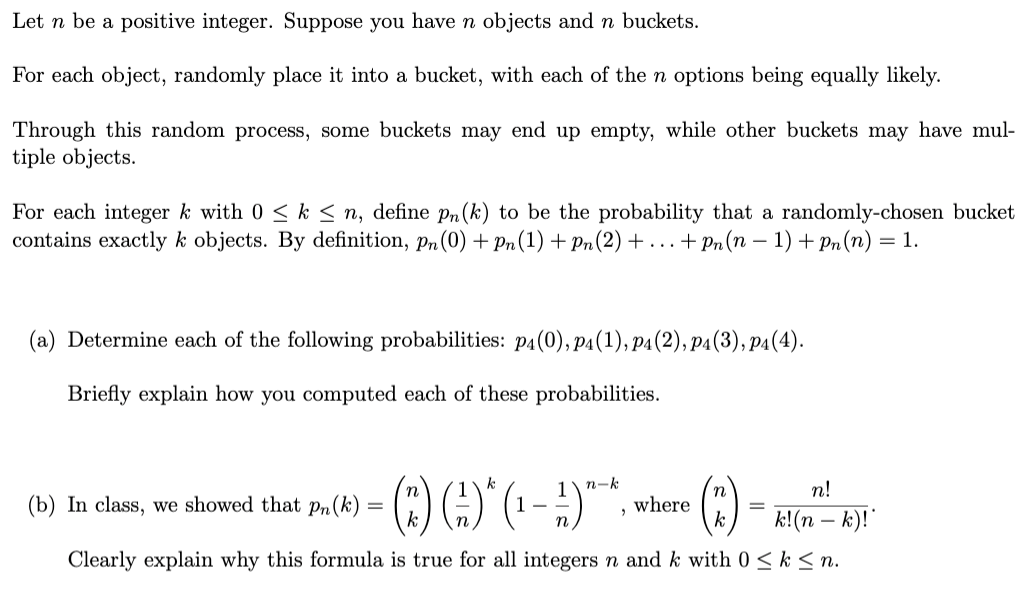Let n be a positive integer. Suppose you have n objects and n buckets. For each object, randomly place it into a bucket, with each of the n options being equally likely. Through this random process, some buckets may end up empty, while other buckets may have mul- tiple objects. For each integer k with 0 < k < n, define pn (k) to be the probability that a randomly-chosen bucket contains exactly k objects. By definition, pn(0) + pn (1) + Pn(2) +. . .+ Pn (n – 1) + Pn(n) = 1. (a) Determine each of the following probabilities: p4(0), p4(1), p4(2), p4(3), p4(4). Briefly explain how you computed each of these probabilities.
Let n be a positive integer. Suppose you have n objects and n buckets. For each object, randomly place it into a bucket, with each of the n options being equally likely. Through this random process, some buckets may end up empty, while other buckets may have mul- tiple objects. For each integer k with 0 < k < n, define pn (k) to be the probability that a randomly-chosen bucket contains exactly k objects. By definition, pn(0) + pn (1) + Pn(2) +. . .+ Pn (n – 1) + Pn(n) = 1. (a) Determine each of the following probabilities: p4(0), p4(1), p4(2), p4(3), p4(4). Briefly explain how you computed each of these probabilities.
College Algebra
7th Edition
ISBN:9781305115545
Author:James Stewart, Lothar Redlin, Saleem Watson
Publisher:James Stewart, Lothar Redlin, Saleem Watson
Chapter9: Counting And Probability
Section9.2: Probability
Problem 2E
Related questions
Question

Transcribed Image Text:Let n be a positive integer. Suppose you have n objects and n buckets.
For each object, randomly place it into a bucket, with each of the n options being equally likely.
Through this random process, some buckets may end up empty, while other buckets may have mul-
tiple objects.
For each integer k with 0 < k < n, define pn (k) to be the probability that a randomly-chosen bucket
contains exactly k objects. By definition, pn(0) + pn (1) + Pn(2) +. . .+ Pn (n – 1) + Pn(n) = 1.
(a) Determine each of the following probabilities: p4(0), p4(1), p4(2), p4(3), p4(4).
Briefly explain how you computed each of these probabilities.
() -
(b) In class, we showed that pPn(k)
1
1- -
n-k
where
k
n!
k!(n – k)!"
n
Clearly explain why this formula is true for all integers n and k with 0 < k < n.
Expert Solution
This question has been solved!
Explore an expertly crafted, step-by-step solution for a thorough understanding of key concepts.
This is a popular solution!
Trending now
This is a popular solution!
Step by step
Solved in 4 steps with 4 images

Knowledge Booster
Learn more about
Need a deep-dive on the concept behind this application? Look no further. Learn more about this topic, advanced-math and related others by exploring similar questions and additional content below.Recommended textbooks for you

College Algebra
Algebra
ISBN:
9781305115545
Author:
James Stewart, Lothar Redlin, Saleem Watson
Publisher:
Cengage Learning

Algebra and Trigonometry (MindTap Course List)
Algebra
ISBN:
9781305071742
Author:
James Stewart, Lothar Redlin, Saleem Watson
Publisher:
Cengage Learning

Elements Of Modern Algebra
Algebra
ISBN:
9781285463230
Author:
Gilbert, Linda, Jimmie
Publisher:
Cengage Learning,

College Algebra
Algebra
ISBN:
9781305115545
Author:
James Stewart, Lothar Redlin, Saleem Watson
Publisher:
Cengage Learning

Algebra and Trigonometry (MindTap Course List)
Algebra
ISBN:
9781305071742
Author:
James Stewart, Lothar Redlin, Saleem Watson
Publisher:
Cengage Learning

Elements Of Modern Algebra
Algebra
ISBN:
9781285463230
Author:
Gilbert, Linda, Jimmie
Publisher:
Cengage Learning,

Algebra & Trigonometry with Analytic Geometry
Algebra
ISBN:
9781133382119
Author:
Swokowski
Publisher:
Cengage

College Algebra (MindTap Course List)
Algebra
ISBN:
9781305652231
Author:
R. David Gustafson, Jeff Hughes
Publisher:
Cengage Learning
